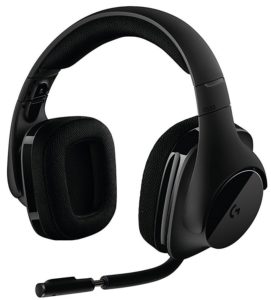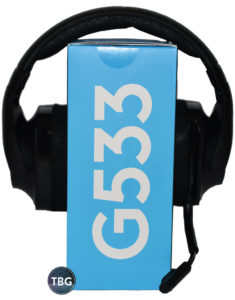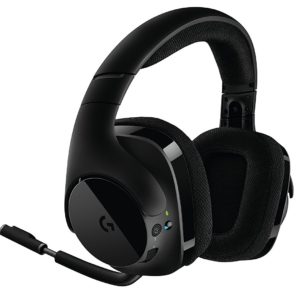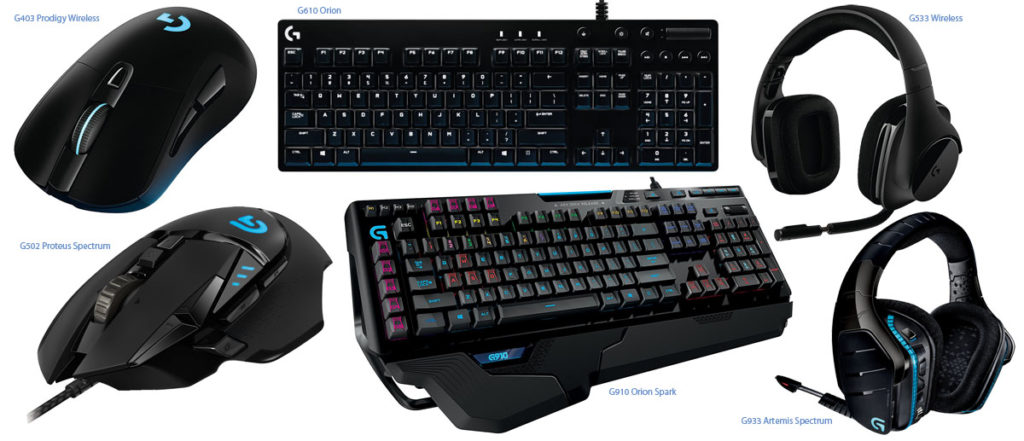Logitech G533 Wireless Gaming Headset Review
Pros
Cons
Rating

Introduction
We’ve tested a number of headphones over the past few years, and one of our very favorites was the Logitech G933 Artemis Spectrum, a wireless model that Logitech launched at CES 2016, at the high-end price of $199.99. Well, Logitech apparently couldn’t leave well enough alone, because at CES 2017, they decided to launch the G533 Wireless Headset at $149.99. The goal isn’t to replace the G933, which offers cross-platform compatibility (the G533 is PC-only), LED lighting, and snazzier styling. Rather, Logitech is looking to put its venerable G930 Wireless Headset out to pasture. That headset, which has been around for over six years, is still by far the best selling wireless headset on Amazon. That being said, it’s no longer cutting-edge, so it only makes sense for Logitech to offer PC gamers a new kit with the latest enhancements at this point, picking up where the old G930 left off. Let’s see whether the G533 has what it takes to live long and prosper!
We’d like to extend a special thank you to Logitech for providing a sample of the G533 Wireless Headset for review.
Description and Features
Looking just at specifications, one could certainly confuse the new G533 for the G933. While Logitech hasn’t published the full specs for the G533 on its website yet, we have the box in front of us, so we can confirm it has the same size 40mm driver, 20Hz-20KHz frequency response, and 107dB SPL/mW sensitivity. The G533’s impedance is 32 Ohms, as opposed to 39 Ohms for the G933. That likely contributes to the higher rated battery life of the G533 (higher Ohms requires more power to drive), although it could also reflect negatively on the sound quality. The specs for the G533’s microphone are identical to the G933’s: 4mm in size, with 100Hz-20KHz frequency response and a unidirectional pickup pattern.
As Logitech explained to us at CES 2017, the G533 is meant to be a more focused product than the G933, and a major improvement on the G930. Apparently, the software team worked hard to shore up the drivers for optimum performance, and the hardware team did the same with the housing, which was reinforced for better acoustics. Could we tell the difference? Well, we’ll say more about that on the next page, but luckily, whatever physical changes were made didn’t negatively affect weight; the G533 came in at 12.4 ounces on our scale, versus 12.9 ounces for the G933. While the G533 wins in this regard, it’s not enough to make a perceivable difference. Both are really, really light for wireless kits, and the lack of a cord makes them feel super-nimble, even compared to lighter wired headsets we’ve tested, like the 9.7oz HyperX Cloud Stinger. The inertia of a cord swinging around makes corded headsets feel far more awkward regardless of weight.
The G533 is also much simpler than the G933, which is why it comes in at a lower retail price (but not selling price, as we’ll discuss in a moment). While the G933 offered cross-compatibility with phones and game consoles via an audio adapter cable, the G533 ships with nothing in the box but a wireless receiver and a USB charging cable. It features just two simple LEDs to indicate operational status: a green light on the back indicates power on, while a red light on the mic indicates mute is active. The G533 drops all the G933’s RGB lights, which honestly aren’t of much use when you’re wearing a headset, unless you want to catch some sideways glances at the local eSports tournament. We have to admit that the lights did look pretty cool, but for most at-home gamers, they were a liability, as battery life maxed out at 12 hours, but dipped down to 8 hours with the lights on. The G533 is rated at 15 hours, but we got 16 hours of battery life in our tests. Runtime can be tracked conveniently in the Logitech Gaming Software (LGS) app. Given that you won’t be fiddling with lights in the app for the G533, the only other reason you might enter the app is to set the EQ and turn on the DTS 7.1 surround. Note that Logitech dropped the Dolby Headphone license this time around; the G933 offered it along with DTS. Another reason you won’t spend much time in LGS: the G533 has just a single shortcut (or “G”) key, which is pre-mapped to mute. The G933 had four shortcut keys.

Luckily, both the G533 and G933 use the same sports mesh, which we like quite a bit. Every brand has its own favored material, each with its own benefits and drawback. HyperX uses a faux leather earcup that’s a bit more supple and on the ear, but less breathable. Corsair uses a mesh that looks similar to Logitech’s, but the foam padding isn’t quite as comfortable. Overall, the G533 is definitely at the head of the class in terms of materials. Another nice feature of the G533, and one it borrows from some of its recent competitors, is the ability to lay at a flat 90 degrees. This means you can perch them on your chest and neck for a quick check-in with friends, family, or competitors and judges mid-tournament. The G933 couldn’t do this quite as well because its earcups swiveled at an angle.
Like the G933, the G533 has a slick fold-away microphone that mutes when stored, but can also be extended and tilted toward the mouth during use. Because Logitech has come up with a way to minimize mic pop without a big foam cover, the headset looks really pro no matter where the microphone is. The solid engineering goes more than skin deep, as Logitech has clearly improve upon the G933, which creaked and rattled more than we liked. In contrast, the G533 feels very solid in use, with not the slightest squeak to its frame. The only element of its design that is clearly a case of form over function are all the glossy black surfaces, which will pick up fingerprints all day long. As we’ll discuss on the next page, this glossy black motif is common to one of the two lines of Logitech gaming peripherals, and we expect to see more of it in the future, for better or for worse.
Now, back to price: the G533 has a retail price of $149.99, which puts it firmly at the high end of wireless gaming headsets. Logitech’s own G930 is $87, Turtle Beach’s Stealth 520 is $100, Corsair’s Wireless VOID is $100, and even Razer’s ManO’War Wireless is $145. While HyperX has a number of wired headsets around $100, it doesn’t market a wireless headset. Finally, SteelSeries has just released its new Arctis 7 Wireless kit right at the $149.99 mark, and it’s probably going to be the toughest competitor for the G533, due to its awesome styling and fuller feature set. Of course, Logitech still has its own higher-end G933, which retails for $200, but like all Logitech products, the G933 has dropped significantly in price since its introduction. Logitech often hits the market at what appears to us to be a somewhat inflated price, perhaps to secure a “premium” market placement, and then allows retailers to discount its products aggressively. Indeed, less than a year since its introduction, the G933 has dropped nearly 33% in price, whereas its competitors released last year still sell for retail. We expect the same thing to happen with the G533, but we can’t review it based on a price it will sell for in the future, we have to review it based on the price at which it sells for today. While it’s clearly a cut above the $100 options out there both in performance and in design, its $150 asking price may be just a bit too high once you realize you can get the G933 for less. And take note: Logitech revealed to us that unlike the G933, which was available in a cheaper wired version, the G533 is exclusively wireless, which means you can’t get a lower price by skipping the wireless feature.

Performance
To get the G533 headset up and running, we had to download the latest version of the Logitech Gaming Software; the headset will not work without it. We had LGS installed already, and were a bit surprised that it could not detect the G533. For a moment, we thought something was wrong, but no, we just needed a newer version of LGS. Note that due to the odd way audio devices work in Windows, you must install the software first, and then insert the wireless adapter, not the other way around. By the way, one feature we miss in the G533 that the G933 had was the ability to store the adapter right in the earcup. That’s going to be a letdown for gamers on the go.
As we discussed on the last page, the biggest threat to the G533 may in fact come from the G933. Because the G933 is the best wireless headset we’ve tested, it’s going to be the baseline. From our point of view, performance of a wireless headset can be broken down into four categories: comfort, sound reproduction, microphone clarity, and wireless fidelity. We’ve discussed comfort on the previous page, and as a reminder, the G533 feels better than just about anything else simply because it’s wireless, and the comfortable earcups do the rest. People with really wide heads may find the headband a bit constricting, and the reality is that headphones are a bit like clothing in that they’ll fit some people perfectly and others will put them “back on the rack” after one try. The G533 could be considered a “slim fit,” so consider that when shopping around.
As for sound quality, the G533 is quite good, but Logitech has clearly made sacrifices to reduce weight and maximize battery life. The 40mm drivers lack bass, which doesn’t bother us too much in a headset, where heavy bass can be distracting. During our music listening tests, though, we initially found the sound very thin, and then realized it was due to DTS 7.1 being activated. You’re definitely going to need to switch it off for music. In stereo mode, the G533 sounded more than decent, although our reference Audio-Technica wired headphones clearly provided more separation, along with better clarity in reproducing quieter elements of a track. But let’s face it, you’re not getting these to compete with wired audiophile headphones, and you’re probably not getting them for music at all, given that they will not work with your portable music devices. Used as intended, for gaming, they excelled, with just the right amount of pop. Furthermore, the DTS 7.1 effect was incredible in games that include a multichannel track. The virtual surround stage provided by DTS works like magic despite having just two drivers, placing sound effects all over the soundstage. It’s totally engrossing, and in our Battlefield 1 tests, we practically felt enemies coming up behind us, making BF1’s visceral version of war in the trenches feel even more real.
With regard to the microphone, we found that quality was excellent, with background noise limited and no popping or hissing. In fact, both of our testers confirmed that compared to other headsets we tested, the microphone produced a “live” sound, as if the speaker using the G533 were right in the room with you, as opposed to the muffled sound you get through, for example, a telephone (and many other headsets). It helps that the boom can be extended and tilted towards the user’s mouth; with many other headsets, it feels like you’re always struggling to get the mic close enough to your mouth. Furthermore, the G533 controlled breathing sounds very well, despite the lack of a foam cover. Finally, we loved the “monitor” feature, which provides a feed of your own voice into the headphones, allowing you to gauge how your voice sounds to others.
The final criterion on which we judge is wireless fidelity. Logitech has this nailed down. By eschewing Bluetooth, it’s able to provide a rock-stable connection with not a hint of static or dropouts when the listener’s head is in motion (as it will be while gaming). While the 15-meter range may sound a bit optimistic, it’s for real. You can walk right out of a room and down the hall and continue listening or conversing, despite the lack of a cord. Try that with a corded headset! We were also pleased to find that the G533 connected on the first try, and every subsequent try, for that matter. We didn’t have quite as smooth an experience with the G933 kit, which sometimes wouldn’t show up as awake and available in the Logitech Gaming Software.
Conclusion
We really like the G533, but we have a little trouble recommending it without reservation at this point due to its price, and in part due to what we view as confusing marketing. Below we’ve put together a compilation of some of Logitech’s top gaming products. What becomes immediately evident when you compare the top row of products to the bottom row of products is that it appears two completely separate design houses are at work. The top row uses glossy textures and subdued, flowing lines. The bottom row of products feature protruding edges, sharp angles, and a multitude of buttons. Even the “G” logos are different!

Our guess is that Logitech is slowly moving its lineup to a more straight-edged, “pro” look, and the new “G” symbol is indicative of that. Unfortunately, the current lineup just doesn’t make much sense. Some new products, like the G403 mouse, come in under the Prodigy name, while others like the G533 headset, do not. Furthermore, while you might imagine that the higher-numbered models are more expensive, that actually isn’t always the case. The G933, as we’ve discussed, is currently cheaper than the G533, while the G502 is likewise cheaper than G403 wireless mouse (although usually more expensive than the similarly-named G403 wired mouse). Frankly, Logitech’s G gaming line is becoming harder and harder for us to navigate, and therefore to explain and recommend to our readers. As an example of how mixed up things have become, both the pro- and gamer-focused keyboard lines use the name “Orion”, and Logitech is in fact selling two different gamer-styled keyboards, the G910 Orion Spark and the G910 Orion Spectrum, which differ only in wrist rest design. Please, Logitech, stop the madness! It’s clear that there’s a “pro-style” line and a “gamer-style” line, and they aren’t remotely the same in terms of aesthetics. But because they sometimes, but not always, overlap in price and functionality, choosing between the two is confusing. We hope that before Logitech continues to expand its gaming lineup, it clearly differentiates between the two market segments, and perhaps even decides to focus on just one or the other.
All that being said, we think anyone who chooses the G533 for gaming will be very pleased with their purchase. In terms of the physical design, the G533 impresses with solid build quality combined with light weight and great comfort. When it comes to performance, the G533 offers excellent DTS 7.1 surround sound in supported games, fantastic battery life, and a brilliant microphone. The Logitech G533 Wireless Headset is available for $150, as of our publication date. We think the price is just a bit high given the competition from the Logitech G933 and offerings from Razer and SteelSeries, but we anticipate it will drop below $120 sooner rather than later. When it does, it will definitely become the top recommended wireless kit in our Speaker & Headset Buyer’s Guide, a spot currently held by its stablemate the G933 Artemis Spectrum.

